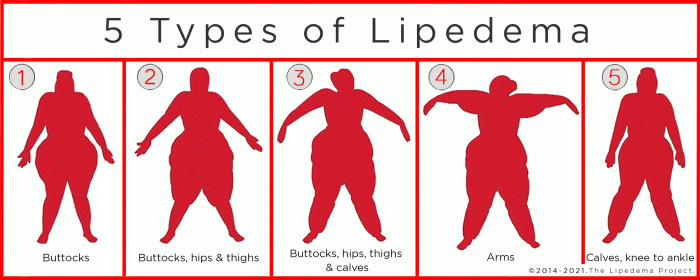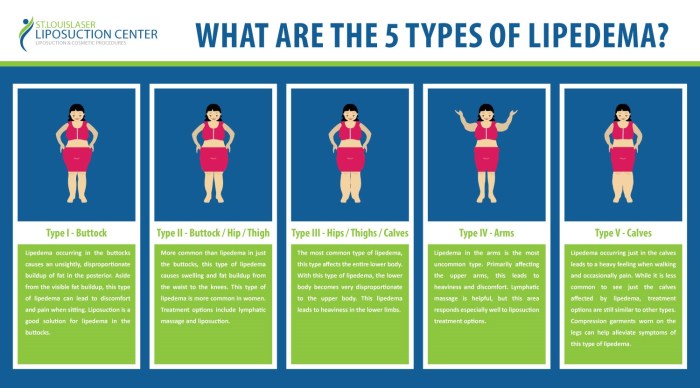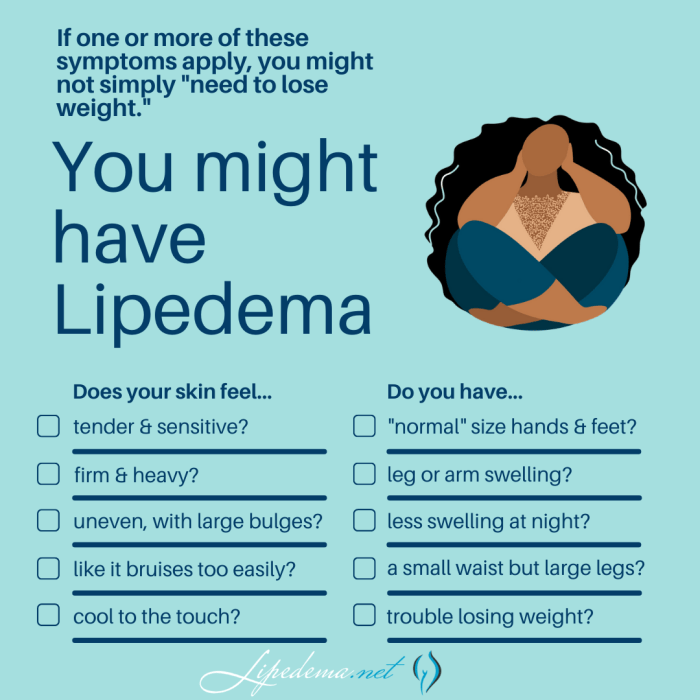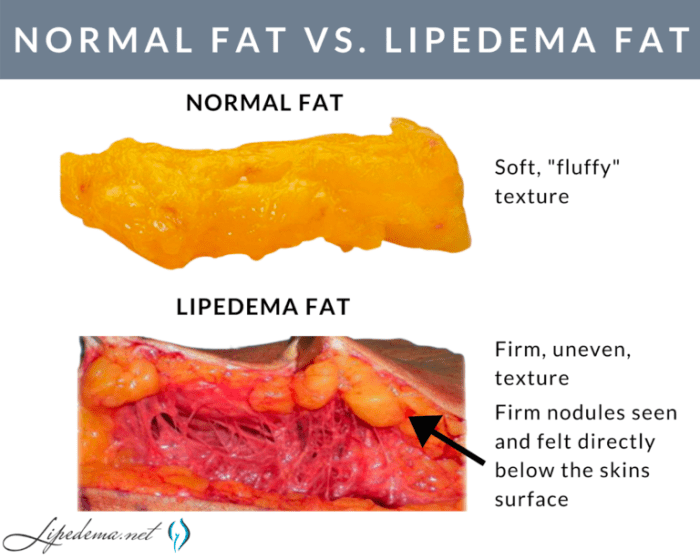Do i have lipedema quiz – Wondering if you have lipedema? Take this quiz to assess your symptoms and risk factors. Lipedema is a chronic condition that causes abnormal fat deposits to accumulate in the legs and buttocks. It’s often misdiagnosed as obesity, but it’s a distinct condition that requires specialized treatment.
This quiz will help you determine if you may have lipedema and provide you with information on next steps.
Symptoms of Lipedema
Lipedema is a chronic condition that causes abnormal fat accumulation in specific areas of the body. It primarily affects women and is characterized by a range of symptoms that can vary in severity.
Common physical signs and sensations associated with lipedema include:
Areas Affected
Lipedema typically affects the lower body, including the:
- Buttocks
- Thighs
- Calves
- Ankles
In some cases, it can also affect the upper arms.
Swelling and Discomfort
Swelling is a prominent symptom of lipedema. The affected areas may feel heavy, tight, and tender to the touch. The swelling can also cause discomfort, pain, and difficulty with mobility.
Skin Changes
The skin in the affected areas may appear dimpled or lumpy, resembling an orange peel. It may also be dry, itchy, and prone to bruising.
Temperature Sensitivity
Individuals with lipedema may experience temperature sensitivity in the affected areas. They may feel cold or uncomfortable in warm environments and have difficulty regulating body temperature.
Reduced Mobility, Do i have lipedema quiz
Severe lipedema can restrict movement and make everyday activities difficult. The swelling and discomfort can limit range of motion and cause pain when walking or standing for extended periods.
Asymmetrical Appearance
Lipedema often causes an asymmetrical appearance, with one leg or arm being significantly larger than the other.
Risk Factors and Causes of Lipedema

Lipedema is a chronic condition that primarily affects women. While the exact cause of lipedema remains unknown, several risk factors and potential causes have been identified.
Risk Factors:
- Gender:Lipedema predominantly affects women, with a much higher prevalence compared to men.
- Family History:A family history of lipedema increases the risk of developing the condition, suggesting a genetic predisposition.
- Obesity:While obesity is not a direct cause of lipedema, it can contribute to the severity of symptoms and make treatment more challenging.
- Hormonal Changes:Lipedema often develops or worsens during hormonal changes, such as puberty, pregnancy, and menopause. This suggests that hormonal factors may play a role in the condition.
- Lymphatic System Issues:Some studies have suggested that impaired lymphatic drainage may contribute to the development of lipedema.
Causes:
The exact cause of lipedema is still unknown, but several theories have been proposed:
- Hormonal Imbalance:Estrogen and progesterone are thought to play a role in lipedema development, as the condition often worsens during hormonal fluctuations.
- Genetic Predisposition:Genetic factors are believed to contribute to lipedema, as it tends to run in families.
- Lymphatic Dysfunction:Impaired lymphatic drainage may lead to fluid retention and swelling, which can contribute to lipedema.
It is important to note that these are potential risk factors and causes, and further research is needed to fully understand the etiology of lipedema.
Diagnosis of Lipedema
Lipedema is often underdiagnosed or misdiagnosed due to its similarity to other conditions like obesity or lymphedema. Accurate diagnosis is crucial for proper treatment and management.To diagnose lipedema, healthcare professionals rely on a combination of physical examinations, medical history review, and imaging techniques.
Physical Examination
During a physical examination, the healthcare professional will assess the affected areas for:
- Symmetrical swelling and enlargement, typically in the legs, thighs, and buttocks
- Soft, doughy texture of the affected tissue
- Absence of pitting edema (indentation when pressure is applied)
- Pain or tenderness in the affected areas
Medical History
A thorough medical history review helps identify risk factors and rule out other conditions. The healthcare professional will inquire about:
- Family history of lipedema
- Hormonal changes (e.g., puberty, pregnancy, menopause)
- Past or present obesity
- History of trauma or surgery
Imaging Techniques
Imaging techniques like ultrasound or magnetic resonance imaging (MRI) can provide additional information and help differentiate lipedema from other conditions.
Ultrasound
Shows the distribution and texture of the affected tissue, distinguishing it from lymphedema.
MRI
Provides detailed images of the affected areas, including the presence of any abnormal fat deposits or other underlying conditions.
Differential Diagnoses
To ensure an accurate diagnosis, healthcare professionals may consider other conditions that share similar symptoms, such as:
Obesity
Excess weight gain throughout the body
Lymphedema
Still curious about the “Do I Have Lipedema Quiz”? If so, you might also enjoy reading catcher in the rye flit , which delves into the complexities of human emotion and experience. While different from the medical focus of the quiz, this literary work offers insights that may resonate with those seeking to understand the complexities of their own health.
Swelling due to impaired lymphatic drainage
Lipohypertrophy
Abnormal fat accumulation in specific areas of the body
Cellulite
Dimpling and uneven texture of the skin due to fat deposits
Treatment Options for Lipedema: Do I Have Lipedema Quiz

Lipedema is a chronic condition that requires ongoing management and treatment. While there is no cure, a combination of conservative and surgical interventions can help reduce symptoms and improve quality of life.
Conservative Treatments
Conservative treatments for lipedema aim to manage symptoms and slow the progression of the condition. They include:
- Compression therapy:Wearing compression garments helps reduce swelling and pain by applying pressure to the affected areas.
- Exercise:Regular exercise, particularly water-based activities like swimming or water aerobics, can help improve circulation and reduce fluid retention.
- Dietary modifications:Maintaining a healthy weight and avoiding processed foods, sugary drinks, and excessive salt intake can help reduce inflammation and improve overall well-being.
Conservative treatments can be effective in managing mild to moderate lipedema, but they may not be sufficient for severe cases.
Surgical Interventions
Surgical interventions for lipedema involve removing excess fat from the affected areas. The two main surgical options are:
- Liposuction:This procedure uses a suction device to remove fat through small incisions in the skin.
- Lipectomy:This procedure involves removing excess skin and fat through larger incisions.
Surgical interventions can be effective in reducing the size and appearance of lipedema, but they come with risks such as bleeding, infection, and scarring.
Risks and Complications
All treatments for lipedema have potential risks and complications. These include:
- Conservative treatments:Compression therapy can cause skin irritation or allergic reactions. Exercise may not be suitable for all individuals with lipedema, and dietary modifications may not be sufficient to control symptoms.
- Surgical interventions:Liposuction and lipectomy can cause bleeding, infection, scarring, and fluid accumulation. There is also a risk of nerve damage and lymphedema.
It is important to discuss the risks and benefits of each treatment option with a healthcare professional to determine the best course of action for individual needs.
Lifestyle Management for Lipedema

Managing lipedema involves adopting a holistic approach that encompasses lifestyle modifications, medical interventions, and emotional support. Lifestyle changes play a crucial role in alleviating symptoms, improving overall well-being, and preventing further progression of the condition.
Maintaining a Healthy Weight
Excess weight can exacerbate lipedema symptoms by increasing pressure on the affected areas. Therefore, maintaining a healthy weight is essential. This can be achieved through a balanced diet and regular physical activity. Consult with a healthcare professional or registered dietitian for personalized guidance on weight management.
Engaging in Regular Physical Activity
Physical activity promotes lymphatic drainage and reduces fluid retention, which can help alleviate swelling and discomfort associated with lipedema. Choose low-impact exercises such as swimming, cycling, or walking to avoid putting excessive strain on the affected areas. Start gradually and gradually increase the intensity and duration of your workouts.
Dietary Recommendations and Nutritional Considerations
A healthy diet is crucial for managing lipedema. Focus on consuming whole, unprocessed foods such as fruits, vegetables, lean protein, and whole grains. Limit processed foods, sugary drinks, and unhealthy fats. Consider consulting with a registered dietitian for personalized dietary recommendations.
Managing Pain, Swelling, and Other Discomforts
Lipedema can cause pain, swelling, and other discomforts. To manage these symptoms, consider the following strategies:
- Use compression garments to reduce swelling and improve circulation.
- Elevate affected limbs to promote lymphatic drainage.
- Apply cold compresses to relieve pain and inflammation.
- Engage in gentle massage to improve circulation and reduce discomfort.
- Consider pain medication as prescribed by your healthcare provider.
Emotional Impact of Lipedema

Individuals with lipedema often face significant emotional and psychological challenges due to the physical manifestations of the condition. These challenges can significantly impact their well-being and quality of life.
One of the most common emotional challenges faced by individuals with lipedema is body image issues. The abnormal accumulation of fat in the legs and buttocks can lead to feelings of shame, embarrassment, and low self-esteem. Individuals may avoid social situations, wear clothing that conceals their affected areas, and experience anxiety about their appearance.
Social Stigma
The social stigma surrounding lipedema can further exacerbate these emotional challenges. Many individuals with lipedema report feeling misunderstood, judged, and discriminated against. This can lead to isolation, withdrawal, and a sense of hopelessness.
Self-Esteem
The combination of body image issues and social stigma can have a profound impact on an individual’s self-esteem. Individuals with lipedema may feel worthless, unattractive, and unable to meet societal beauty standards. This can lead to depression, anxiety, and other mental health concerns.
Coping Strategies
Coping with the emotional aspects of lipedema is crucial for maintaining overall well-being. Some strategies that may be helpful include:
- Seeking support from family, friends, or a support group.
- Engaging in therapy to address body image issues and self-esteem.
- Practicing self-care activities such as exercise, meditation, and healthy eating.
- Educating oneself about lipedema and its impact on emotional health.
- Advocating for oneself and others with lipedema to reduce stigma and promote understanding.
Clarifying Questions
What is lipedema?
Lipedema is a chronic condition that causes abnormal fat deposits to accumulate in the legs and buttocks. It’s often misdiagnosed as obesity, but it’s a distinct condition that requires specialized treatment.
What are the symptoms of lipedema?
Symptoms of lipedema include:
- Swelling in the legs and buttocks
- Pain and tenderness
- Bruising
- Easy fatigue
- Difficulty walking
What causes lipedema?
The exact cause of lipedema is unknown, but it’s thought to be related to hormonal changes and genetics.
How is lipedema treated?
There is no cure for lipedema, but treatment can help manage symptoms and improve quality of life. Treatment options include:
- Compression therapy
- Exercise
- Dietary changes
- Liposuction